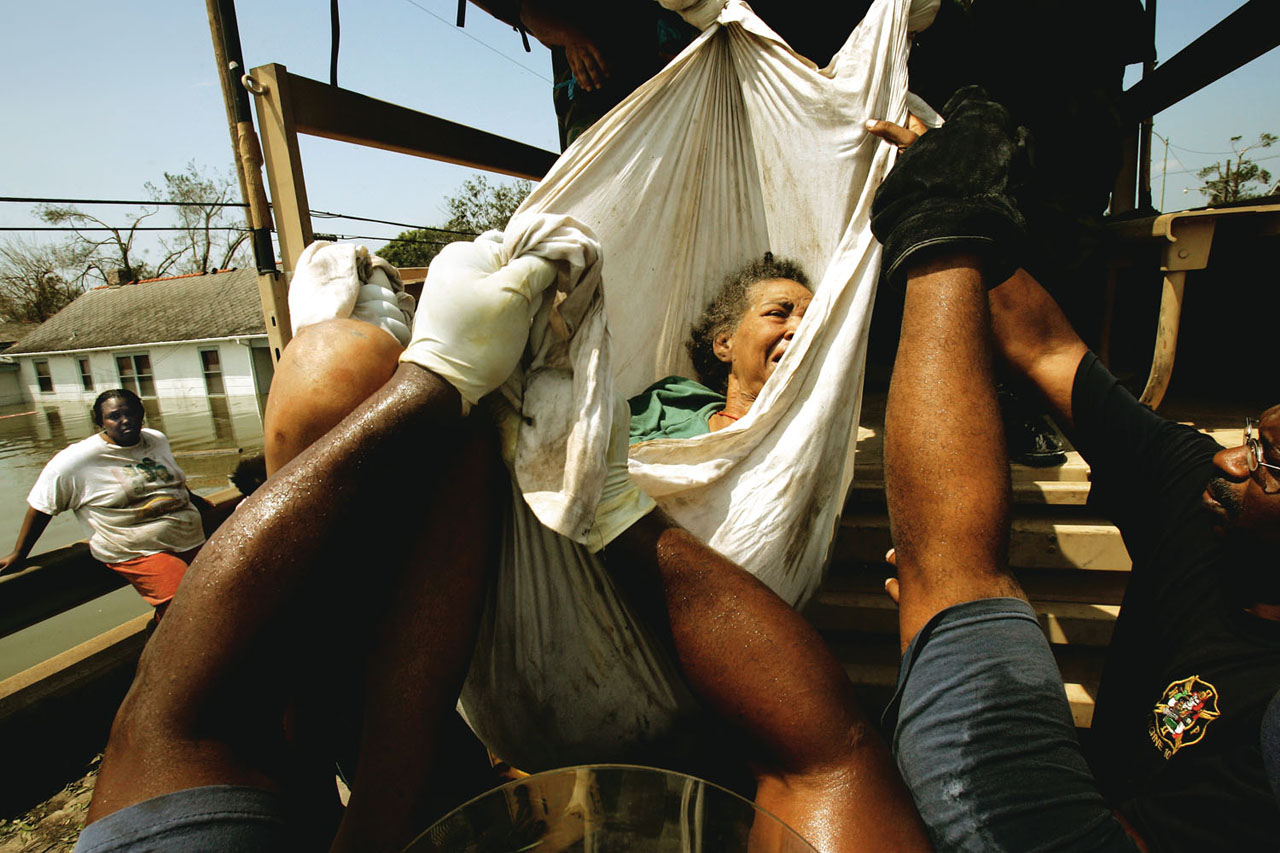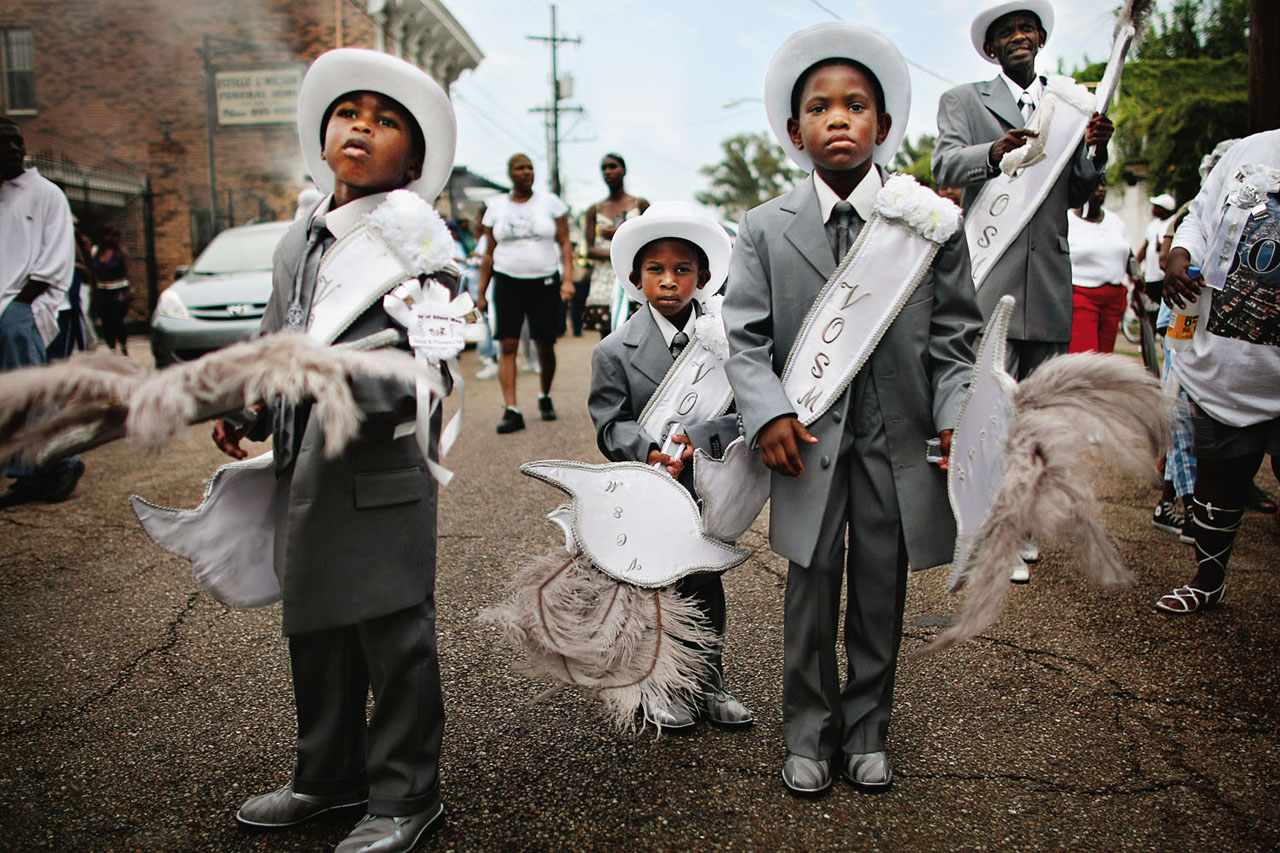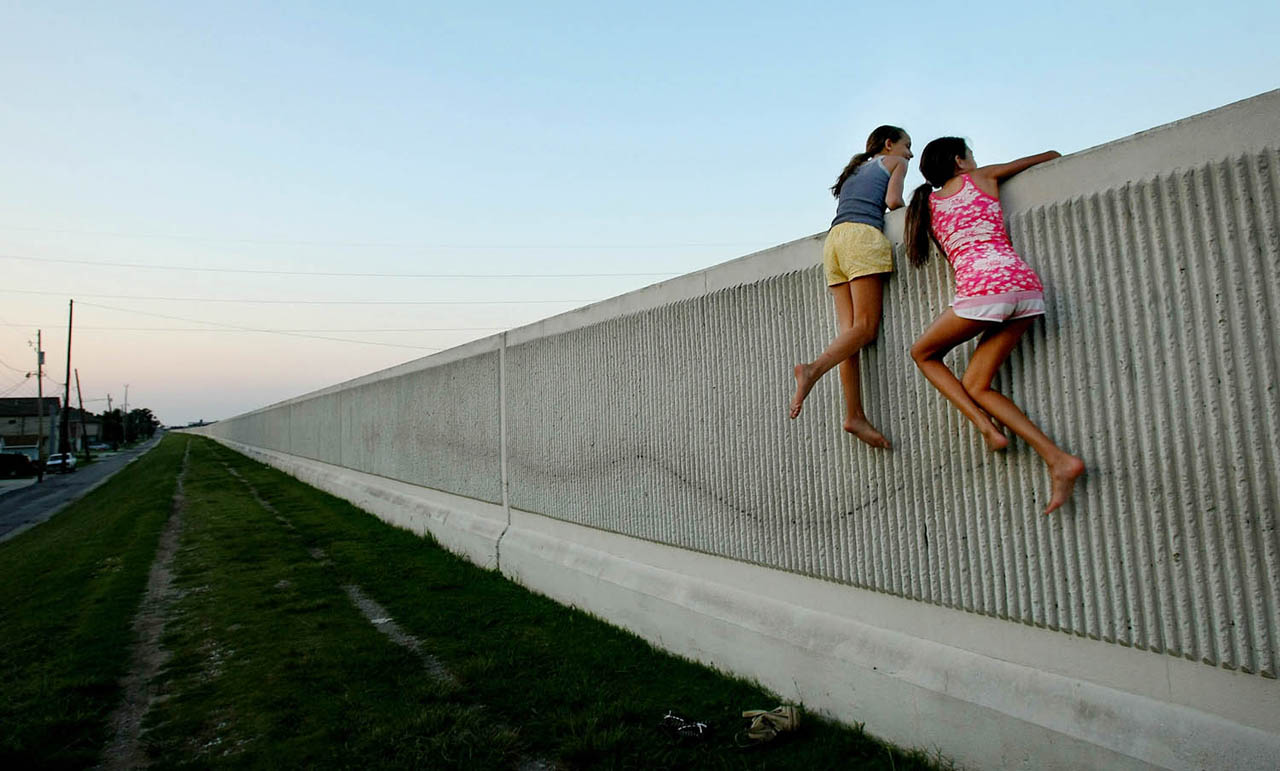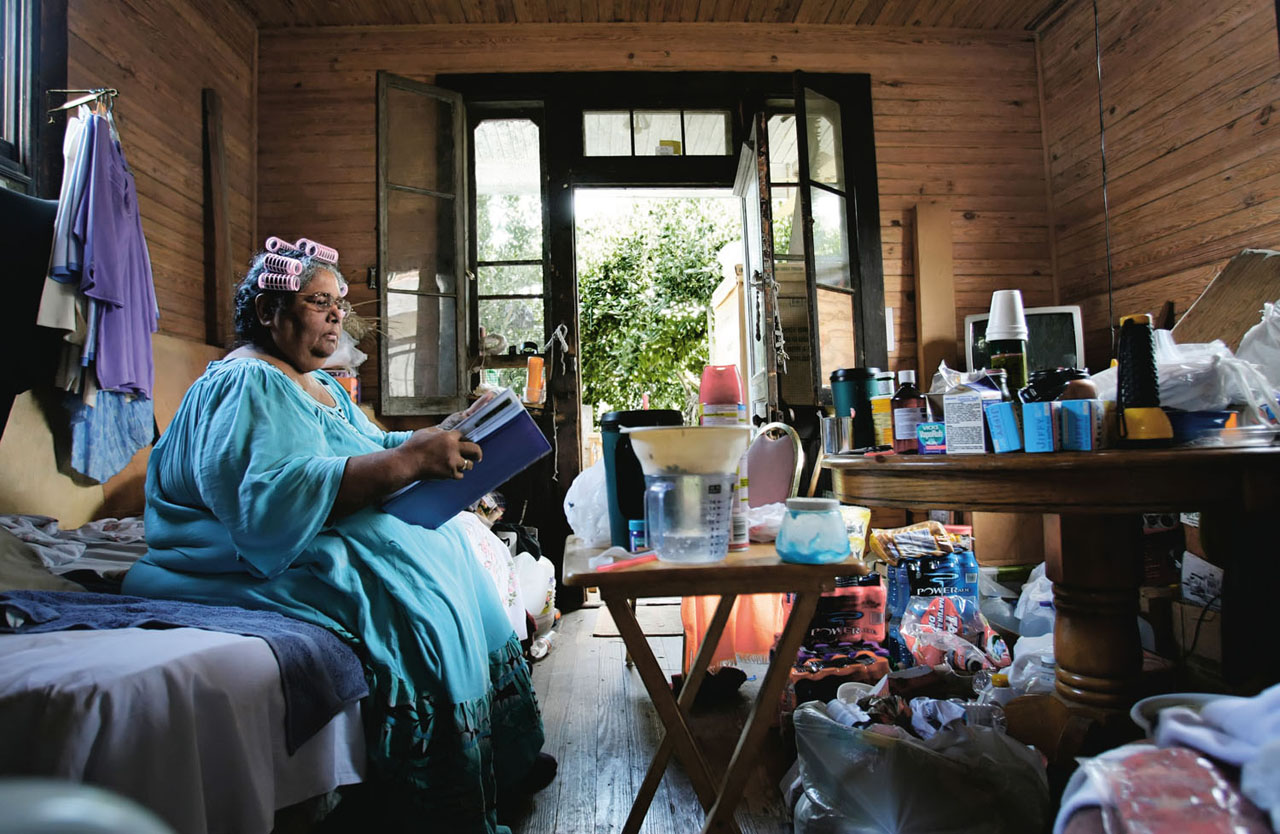at Length
Mario Tama
photography by Mario Tama
interview by Darren Ching and Debra Klomp Ching
For the past five years, Getty Images photographer Mario Tama, has been documenting Hurricane Katrina’s devastation and the recovery process of New Orleans and its people. Coming Back: New Orleans Resurgent, is his newly released book published by Umbrage.
September 6, 2005—A resident walks past a burning house fire in the 7th ward, New Orleans. Fire companies are struggling to combat fires in the city with no water pressure and difficult communications.
At Length: What was it like for you, as a photographer, when you first arrived in New Orleans to cover Hurricane Katrina?
Mario Tama: It was apparent from the moment I stepped off the plane in New Orleans, two days before the storm, that the situation would be chaotic. I had reserved an SUV through a car rental agency, but as I arrived at the counter, the line was endless and there was only one poor soul manning the desk, the rest of the workers had fled. It was impossible to get a car from the regular agencies, but I was lucky enough to get the last vehicle available from a local agency, a Toyota Corrolla, not exactly the type of vehicle one hopes for to cover a hurricane. As I arrived into the city, many local residents were checking into hotels in the French Quarter, as they knew the Quarter was on high ground. Of course, the poorest residents could not afford a room in the Quarter and the buses that were supposed to be provided to evacuate them never arrived. I rode out the storm in the Holiday Inn in the Quarter and ended up on a rescue boat in the Lower Ninth Ward the following day. I recall at one point our boat became stuck on something, nearly tipping over. And as we looked down it turned out we were stuck on the top of someone’s roof. It was at that moment the immensity of the disaster became brutally apparent.
AL: At what point and why did you decide to compile your Katrina work into a book?
MT: Reportage photo editor Lauren Steel approached me about doing a book and of course I jumped at the chance. It had been in the back of my mind for a while, but I wasn’t really sure of the best way to approach it. I always felt the story was just too massive, too complex, to possibly be captured in a few images or in moments just following the storm. New Orleans has withstood 27 major floods over the past 290 years or so, so the real story was never just about Katrina, but about the resilience and spirit of the people who always manage to overcome and endure. We also wanted to give something back to the community, so I’m very proud that Getty Images will donate 100 percent of the royalties from this book to New Schools for New Orleans.
August 30, 2005—A woman is placed into an Army vehicle after being rescued from her home in high water in the Lower Ninth Ward during the aftermath of Hurricane Katrina, New Orleans.
AL: You have had assignments in Haiti, Iraq, Afghanistan, 9/11—what was it about New Orleans that compelled you to continue documenting the city over the course of 5 years?
MT: I think I connected with the people of New Orleans on a deeper level than I ever had with my subjects before. I had fallen in love with the city years before Katrina, so I knew what an amazing place it was and I just felt that if the people were going to try to come back, I would try to come back with them. I think riding on boats with them in the Lower Ninth, walking through the floodwaters with them around the Superdome, waiting on overpasses with them to be rescued, all these experiences created an unbreakable foundation of solidarity. I’m not in any way, shape, or form a nationalist, but at the same time, there is something different, something more disturbing, about documenting people of your own country in such dire circumstances. I felt that if I were to truly be an American photojournalist, it was my duty to follow this story as thoroughly and sensitively as I could.
August 31, 2005—Two men paddle in high water after Hurricane Katrina devastated the area, New Orleans.
AL: Were there certain parts of the city that you focused on during your return visits?
MT: Yes, I focused of course on the Lower Ninth Ward, which is the first area of the city I photographed in the aftermath. I also focused on the B.W. Cooper housing projects, the projects were a very controversial subject following Katrina, and most were torn down. No one claimed that the projects were an ideal place to live, there was a terrible history of violence, drugs and crime in the projects. However, they were home to thousands of the poorest New Orleanians and a true incubator of New Orleans culture. Most of the people who lived there have now been priced out of the city. But I was able to photograph one section of B.W. Cooper that has remained open and I was indescribably drawn to the spirit of the people there. They truly embody resilience. Speaking of resilience, I also spent a lot of time in the FEMA Diamond trailer park in Port Sulphur, Louisiana. There were still people living in FEMA trailers down there four years after Katrina hit. The conditions were absolutely deplorable and shameful especially here in the richest country on Earth.
September 1, 2005—Stranded survivors wait in the Superdome, New Orleans.
AL: Being a staff photographer for Getty, how did you manage to spend so much time shooting in one location and on the same project?
MT: I was very fortunate that my Director of Photography, Pancho Bernasconi, understood the importance of this story. We had many discussions about how to cover it and we ended up coming up with ways to keep our coverage relevant. For instance, I would visit at times when New Orleans was in the news, like during elections, or at the beginning of hurricane season, or when presidential candidates came through town. Or we would cover other newsworthy moments like Easter and Thanksgiving in New Orleans. Even during my longer stints I would cover stories for the Getty wire in New Orleans which had very little to do with Katrina, such as immigrant rallies and oil production. There is enough going on in New Orleans that one doesn’t have to only photograph stories related to Katrina. Another big help was a great little bed and breakfast I found, the Crescent City Guest House, which charged me extremely reasonable rates, making coverage easy on the budget.
AL: It’s been five years since Hurricane Katrina devastated New Orleans, how has the rebuilding of the city progressed; have things changed during your trips there?
MT: I have heard the city compared to a stroke victim, in the sense that most areas seem to be functioning normally but certain areas are completely nonfunctional. If you visit the French Quarter or the Garden District there is basically zero evidence of Katrina. But if you go to certain parts of the Lower Ninth, homes remain destroyed and in fact a significant amount of the Lower Ninth Ward has now been overtaken by wild vegetation. It is coming along, slowly but surely.
May 28, 2008—Kailah Smith, 18 months, sleeps on a couch covered in mold caused by rain leaks in her parents’ FEMA trailer, just before the family moved out of the trailer to an apartment, Port Sulphur, Louisiana. Smith’s parents had to hospitalize her with bronchitis four times since they moved into the trailer and they said they were sure the trailer was to blame for her illnesses. Doctors fear tens of thousands of children were exposed to dangerous levels of the cancer-causing agent formaldehyde in the post-Katrina FEMA trailers and could have lifelong illnesses.
AL: During the time that you have spent in New Orleans, it must have been overwhelming witnessing the transition from the devastation to the recovery process, as well as the resulting good and bad aspects of human nature?
MT: This story has been an incredible roller coaster of emotions and experiences, but I’m thrilled to say almost every new visit seems to mark another milestone of progress and redemption. Of course some of the worst elements of humanity were manifested in the aftermath, but what truly sticks out in my mind is the strength of community, the bonds of family, the inherent decency of most humans, who bonded together, pulled themselves up by their bootstraps, and reclaimed their city. When you mention bad aspects of human nature, the thing that immediately pops to mind was the negligence and ineptitude of our government, which was deeply disturbing. Most people who went through Katrina will tell you they will never have faith in government again.
August 26, 2007—Boys participate in the Valley of the Silent Men Social Aid and Pleasure Club Second Line Parade, New Orleans.
AL: For a good time after the hurricane there was quite a media frenzy in and around New Orleans. Were there any major challenges that you faced as a photographer, coming from the outside?
MT: The challenges I faced were nothing compared to what the people of New Orleans and the Gulf Coast faced. I was very fortunate. I slept in my car for a couple nights following the storm before luckily finding a new hotel room, albeit without electricity or running water. I had a satellite phone to transmit pictures with, but it barely worked. I was eventually able to send images via a landline that somehow worked in a local bar. Driving through the flooded streets in a Toyota Corolla was not exactly optimal, and many times the only option was to wade through the floodwaters on foot, sometimes with cameras hoisted overhead. A police officer tried to commandeer all my gasoline at one point, that would have possibly put an end to my coverage. At one point the National Guard blocked myself and some other photographers from re-entering the city, but we were able to find another way in.
May 29, 2008—Isabella Lander and Arabella Christiansen climb on the 17th Street Canal levee, Metairie, Louisiana.
AL: A lot had been said about the inadequate government response during the Katrina crisis, how did people help each other out during that time?
MT: In the Lower Ninth Ward I saw citizens on boats, even canoes, rescuing their neighbors from rooftops and delivering food and water to those trapped inside their homes. Although most of the governmental response was mediocre, The U.S. Coast Guard and Louisiana Dept. of Wildlife and Fisheries both did an excellent job with rescues. Even in places as miserable as the Convention Center, I remember people still telling jokes and trying to smile, which is the New Orleans way, it is a communal method of getting through hardship.
August 24, 2007—Retired seamstress Rita Gillett, 63, sits in her damaged home in the Lower Ninth Ward where she lives with her husband Hazzert, New Orleans. The couple still lived without electricity or gas because they weren’t able to secure government assistance to pay for the repairs.
AL: Much of the recent press on the Gulf Cost has focused on the BP oil spill, how are the residents dealing with yet another tragedy?
MT: I think initially it was a big shock and of course people are angry and upset, but as time has passed I see once again the resilience shining through. Living down here is truly a way of life, and people will fight to keep their way of life with every bone in their body.
AL: You are currently in New Orleans on assignment right now. What’s the mood like during the 5th anniversary of Katrina?
MT: I think it’s difficult to guage an exact mood, a lot of people just want to look forward and forget about Katrina, understandably so. Others want to honor those who perished. And still others want to celebrate a little bit, like the dancers I photographed at a second line parade in the Lower Ninth. As they say down here, “In New Orleans, we put the ‘fun’ in funeral.”
November 26, 2009—Camilla Brewer attends the Thanksgiving Day horse races at the Fair Grounds Race Course, New Orleans. Each year people don their Thanksgiving finest and watch the races in an old New Orleans tradition.
AL: Do you feel that your relationship with the city and its people has changed since you started the project?
MT: Yes my relationship with the city has grown much deeper, I understand more about the history of the neighborhoods and the cultural significance of the various rituals that embody New Orleans. When I come down here now it usually takes about a day to de-New Yorkerize myself and get into the graceful unhurried rhythm that exemplifies New Orleans life. The two cities are different in so many ways, but one thing both cities absolutely share in common is amazing people. I feel so blessed to have been able to witness and document the spirit of so many incredible New Orleanians along with the resplendent intricacies of New Orleans life. It is truly one of those places where the more you know, the more you know you don’t know. So it has been a great education and I hope it continues for a long time.
June 6, 2007—B.W. Cooper housing project resident Leianne LaRoche holds niece Destiny Herbert, two, as they jump rope using a phone cable in front of their apartment, New Orleans.
AL: The Getty Images royalties from Coming Back: New Orleans Resurgent are going to the New Schools for New Orleans. How did NSNO become involved with the project?
MT: The book has an emphasis on children, and so when a friend suggested I speak to Sarah Usdin, founder and CEO of NSNO, I jumped at the chance. We hit it off immediately and they just seemed like the perfect cause for this project. One of the silver linings of Katrina was that the school system was so devastated they were able to practically start over from scratch.
AL: What do you hope to achieve through the publication of this book?
MT: I hope people will never forget what happened here. It is a terrible mark on our nation’s history and the only way history won’t repeat itself is of course if we learn from the grave errors that occurred in 2005. But more importantly, I hope this book will serve as a reminder that New Orleans is a cultural cradle of our country, an extremely important and vital link to our nation’s history and to her future. The suggestion made in some circles that New Orleans shouldn’t be rebuilt was, to me, utterly preposterous and could only have been made by people who had never actually set foot in this glorious city. It is a city where history lives on in every corner and its citizens carry a vigorous and rarified strand of the very DNA of the American experience. I hope the book calls attention to that.
The book signing and launch for Coming Back: New Orleans Resurgent will take place on Wednesday, September 8, 6–8pm at Umbrage Gallery, 111 Front Street in Dumbo, Brooklyn. Selected images from the book are on view at the gallery through September 15, 2010.
To see more work by New York-based photographer Mario Tama, visit his website. Tama is a staff photographer for Getty Images. All images © Mario Tama/Getty Images









